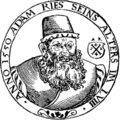Template:Selected anniversaries/March 30: Difference between revisions
No edit summary |
No edit summary |
||
| Line 38: | Line 38: | ||
File:Stefan Banach.jpg|link=Stefan Banach (nonfiction)|1892: Mathematician and academic [[Stefan Banach (nonfiction)|Stefan Banach]] born. He will be one of the founders of modern functional analysis. | File:Stefan Banach.jpg|link=Stefan Banach (nonfiction)|1892: Mathematician and academic [[Stefan Banach (nonfiction)|Stefan Banach]] born. He will be one of the founders of modern functional analysis. | ||
||Erwin Panofsky (March 30, 1892 | ||Erwin Panofsky (b. March 30, 1892) was a German-Jewish art historian, whose academic career was pursued mostly in the U.S. after the rise of the Nazi regime. Panofsky's work represents a high point in the modern academic study of iconography, which he used in hugely influential works like his "little book" Renaissance and Renascences in Western Art and his masterpiece, Early Netherlandish Painting. | ||
||1894 – Sergey Ilyushin, Russian engineer, founded Ilyushin Aircraft Company (d. 1977) | ||1894 – Sergey Ilyushin, Russian engineer, founded Ilyushin Aircraft Company (d. 1977) | ||
| Line 57: | Line 57: | ||
||1922 – Arthur Wightman, American physicist and academic (d. 2013) | ||1922 – Arthur Wightman, American physicist and academic (d. 2013) | ||
||Ilya Piatetski-Shapiro (b. 30 March 1929) was a Soviet-born Israeli mathematician. During a career that spanned 60 years he made major contributions to applied science as well as pure mathematics. In the last forty years his research focused on pure mathematics; in particular, analytic number theory, group representations and algebraic geometry. His main contribution and impact was in the area of automorphic forms and L-functions. Pic. | |||
||Sir Charles Vernon Boys, FRS (d. 30 March 1944) was a British physicist, known for his careful and innovative experimental work. | ||Sir Charles Vernon Boys, FRS (d. 30 March 1944) was a British physicist, known for his careful and innovative experimental work. | ||
Revision as of 07:50, 1 April 2018
1599: Mathematician Adam Ries dies. He wrote textbooks for practical mathematics, promoting the advantages of Arabic/Indian numerals over Roman numerals.
1811: Chemist and academic Robert Bunsen born. He will investigate emission spectra of heated elements, and discover caesium (in 1860) and rubidium (in 1861) with the physicist Gustav Kirchhoff.
1862: Mathematician, philosopher, and crime-fighter Antoine Augustin Cournot uses the ideas of functions and probability to locate and apprehend math criminals.
1886: Mathematician, philosopher, and logician Stanisław Leśniewski born. He will posit three nested formal systems, to which he will give the Greek-derived names of protothetic, ontology, and mereology.
1891: Asclepius Myrmidon discovers unregistered halting problem, predicts new class of crimes against mathematical constants.
1892: Mathematician and academic Stefan Banach born. He will be one of the founders of modern functional analysis.
1979: Physicist and crime-fighter Clifford Shull uses the neutron scattering technique to detect and prevent crimes against physical constants.
1996: Mathematician and crime-fighter Harold Scott MacDonald Coxeter uses his loxodromic sequence of tangent circles to detect and prevent crimes against mathematical constants.
2018: Math photographer Cantor Parabola attends Minicon 53, taking a series of photographs with temporal superimpositions from Minicons 52 and 54.








